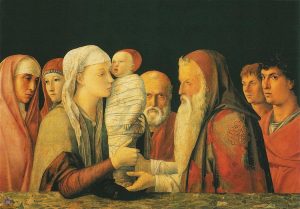Words on the Word
Candlemas
Anyone who regularly prays the rosary will be struck, I think, by a strange, beautiful symmetry running across the four series of mysteries. We might consider the first mystery in each series, simply lining them up side by side: the Annunciation to Mary, marking the beginning of Christ’s incarnate life; the baptism in the Jordan, marking the beginning of his public ministry; the agony in the garden, marking the beginning of his saving Passion; and the resurrection from the dead, marking the beginning of a new humanity. By virtue of daily recitation, these different perspectives merge in a kind of semantic accretion, or — if you like — in a symphony of voices, like the carefully balanced parts of a Renaissance motet. And we are drawn ever further into the boundless grace of Christ’s gift, of his presence in our midst, of his life in us, in so far as we are open to receive it.
The event we celebrate today, the Presentation in the Temple, occurs as the fourth Joyful mystery. It has us meditate on Mary and Joseph’s obedience to the Law; on their readiness to give back the Son given them. As man, Jesus is offered. As God, he takes possession of the house that is his dwelling by right, as we read in the prophet Malachi. The two-fold nature of Christ, fully God and fully man, is put before us.
If we turn to the fourth in the series of Luminous mysteries, we find this perspective developed. On Mount Tabor, Christ reveals himself in light, opening the eyes of his disciples to a fact they may have suspected, but not yet fully owned: that their Friend and Master is also, in the strict sense, Lord. He is the Burning Presence before which our nature cannot stand. It must fall to the ground in adoration and awe, until God himself in his kindness — his philanthropy, the Fathers would say — raises it up.
The fourth Sorrowful mystery has Christ ascending another Mount, that of Calvary, carrying his Cross. The God-Man appears to us here in his most paradoxical aspect. We see him, with St Paul, ‘in the form of a slave, not counting equality with God a thing to be grasped, but emptying himself unto death, even death on a cross’. This, too, is a Presentation in the Temple of sorts. In his letter to the Romans, Paul designates the cross as ἱλαστήριον, an altar of propitiation. We are subtly reminded that Jesus enters his sanctuary not only to be ransomed as man, not only to take possession of it as God, but also to be offered within it as a Lamb.
And the Glorious mysteries? There, the fourth puts before us the assumption of our Lady into heaven. Paradise, of which the earthly Temple is an image, is no longer shut to man. Christ, ‘uniting all things in himself’, did not enter it alone; in his body, he carried us with him. He was presented in the Temple, today’s collect proclaims, ‘cum nostræ carnis substantia’, ‘with the substance of our flesh’. Our nature as such is involved in this event. Christ’s wish is that we should abide where he abides, that not a single one given him by his Father should perish. Mary went first, to make things ready. And is it not true that the notion of home, of coming home, is intimately, sweetly linked in our experience with the welcoming presence of our mother?
Today, then, we not only accompany Christ through the fulfilment of a Mosaic prescription; we get a foretaste of what will be our own eternal destiny, if we stay faithful to God’s call. In a wonderful phrase in a sermon for this feast, St Sophronius of Jerusalem exhorts us: ‘Let us be shining ourselves as we go together to meet the light whose brilliance is eternal.’ That is a pretty compact summary of our Christian vocation. To it we can only say, ‘Amen, Amen!’

Andrea Mantegna, The Presentation in the Temple (1453). WikiArt.
